The new Mars rover Curiosity has been on Mars now for 10 days, following its daring and unprecedented landing on August 5-6, 2012. The landing captured the world’s imagination, and, since then, the rover has been giving us wonderful photos of Mars. The rover spent last weekend – its first weekend on Mars – transitioning to software better suited for the tasks that lie ahead of it, such as driving and using its robotic arm. One thing you don’t want to miss is this high-def 360-degree panorama of Mars’s surface. Otherwise, here are some of my favorites among Curiosity’s images so far.
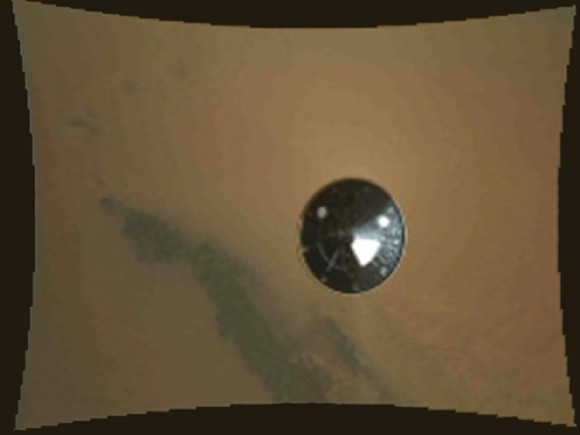
The image above is not part of the Curiosity rover itself. Instead, it’s the rover’s heat shield falling away from the bottom of Curiosity as the rover plunged toward the Martian surface.
More from Curiosity’s descent. NASA released a stop motion video, above, showing the final minutes of Curiosity’s descent from the release of the heat shield to the surface. You can see the heat shield falling away as the rover plummeted through the Mars’ atmosphere. Toward the end, you can see dust was being kicked up as the rover was being lowered by cables to its resting place in the Gale Crater on Mars.
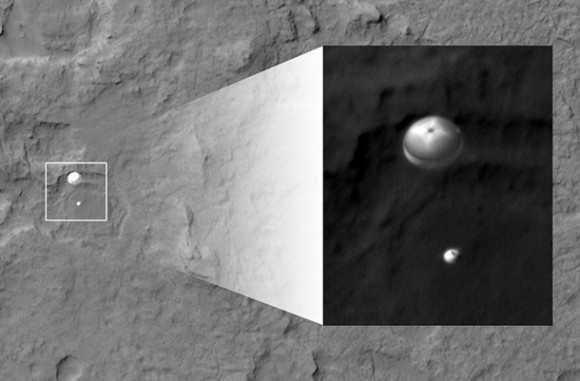
All the descent images, I like the one above the best. You can’t not like the image above. It’s the Curiosity rover descending by parachute to the Martian surface. Another spacecraft in orbit around Mars, NASA’s Mars Reconnaissance Orbiter – which carries the High-Resolution Imaging Science Experiment (HiRISE) camera – captured this image of Curiosity while the orbiter was listening to transmissions from the rover. Curiosity and its parachute are in the center of the white box. The rover is descending to Mars’ surface. From the perspective of the orbiter, the parachute and Curiosity are flying at an angle relative to the surface, so the landing site does not appear directly below the rover.
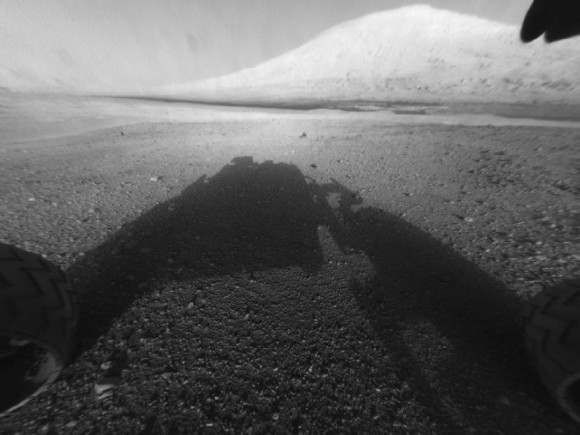
Mars landed in Mars’ Gale Crater on Mars. Its primary science goal is to explore Mount Sharp – aka Aeolis Mons – which forms the central peak within the crater. Here is one of Curiosity’s first views of Mt. Sharp, a 5.5-kilometer (18,000-foot) high mountain. Curiosity will drive to the base of the mountain and see what’s there. See the image at the bottom of this post to get some wider context of where Curiosity landed within the Gale Crater. By the way, in the image above, what’s that shadow in the foreground? It’s the shadow of the rover itself.

I love the image above. It’s the first color image of Curiosity from orbit. NASA’s Mars Reconnaissance Orbiter captured this image of Curiosity on the surface of Mars one day after the landing.
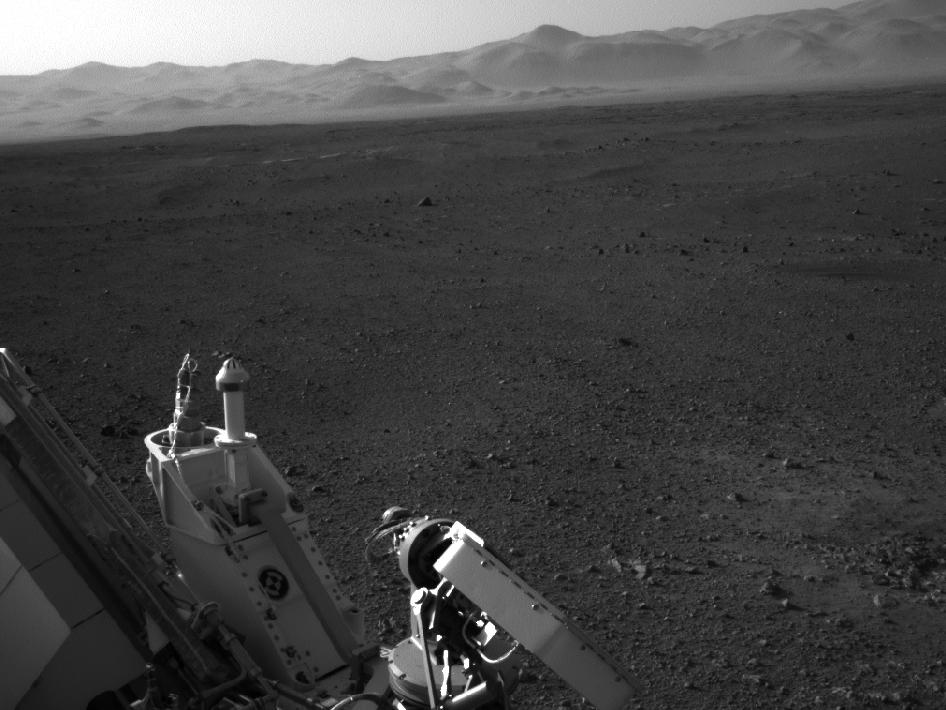
Curiosity captured the image (above) of itself and the Mars landscape surrounding it on August 7. This image shows part of the deck of the rover taken from one of its navigation cameras, looking toward the back left of the rover. On the left of this image, part of the rover’s power supply is visible. To the right of the power supply can be seen the pointy low-gain antenna and side of the paddle-shaped high-gain antenna for communications directly to Earth. The rim of Gale Crater is the lighter colored band across the horizon. The effects of the descent stage’s rocket engines blasting the ground can be seen on the right side of the image, next to the rover.
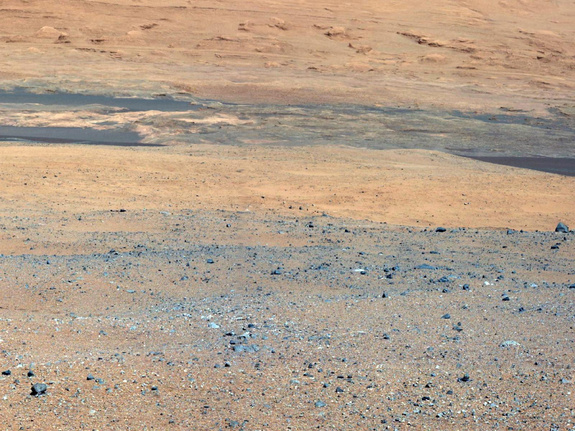
Then on August 8 came the image above. Now the rover is looking southward from its landing site, towards Mount Sharp again. NASA says that, in this version of the image, colors have been modified as if the scene were transported to Earth and illuminated by terrestrial sunlight. This processing, called “white balancing,” is useful for scientists to be able to recognize and distinguish rocks by color in more familiar lighting. NASA said:
The image provides an overview of the eventual geological targets Curiosity will explore over the next two years, starting with the rock-strewn, gravelly surface close by, and extending towards the dark dunefield. Beyond that lie the layered buttes and mesas of the sedimentary rock of Mount Sharp.

Also on August 8 came this self-portrait of the rover on Mars. NASA called this a “self-portrait with rover.” I love it. I only wish I could live long enough to see a real image like this of our entire Milky Way galaxy. Read more about the rover’s self-portrait here.
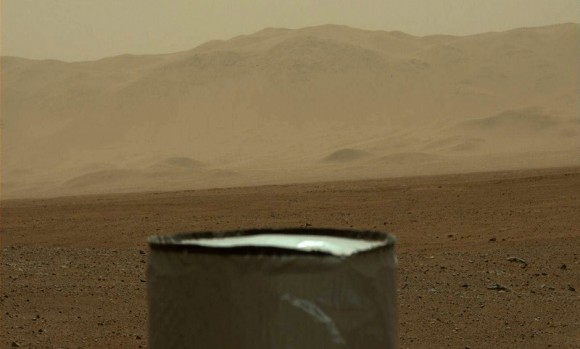
The image above – released by NASA August 9, 2012 – shows a view taken by shows the mountains looming in the distance in front of Curiosity. These mountains form the crater wall north of the landing site, or behind the rover. At this part of the crater, a network of valleys – believed to have formed by water erosion – enters Gale Crater from the outside.
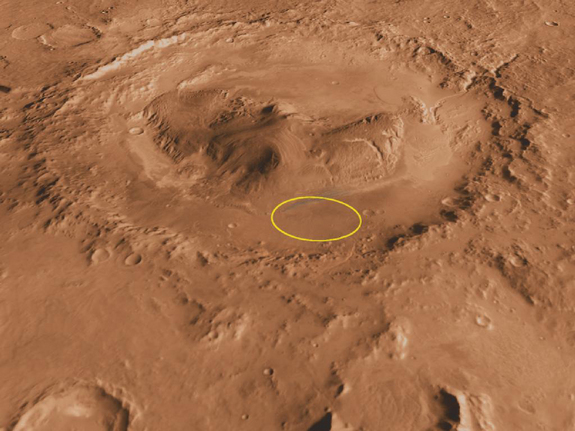
Here’s a good image (above) of Curiosity’s location within the Gale Crater itself. Where is Curiosity within the largest context of Mars’ surface? Check out landing sites of previous Mars rovers and Curiosity
And last but not least, don’t forget that Mars is visible to your eye alone in our night sky. The image above is from early August, around the time Curiosity landed on Mars. If you looked outside for Mars tonight – gazing in the west after sunset – you’d find that it’s still in a triangle with two other objects, the planet Saturn and star Spica in the cosntellation Virgo. Mars has been moving with respect to those other two objects, though, over this past week. It’s now on the left side of the triangle instead of on the right. Here’s more about how to spot Mars in the west after sunset.
By the way, Space.com has an awesome video animation showing how the Curiosity looked and sounded during its descent to Mars’ surface. Enjoy it.
Bottom line: Here are my favorite images of Curiosity – or from Curiosity – taken in the 10 days since the Mars rover landed on the Red Planet’s surface on August 5-6, 2012.











